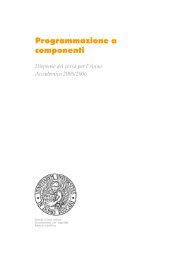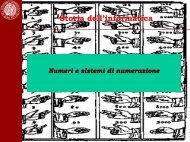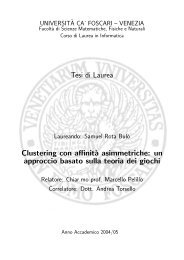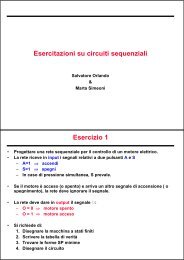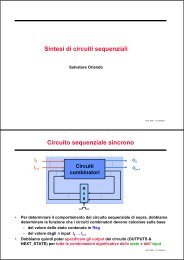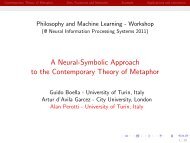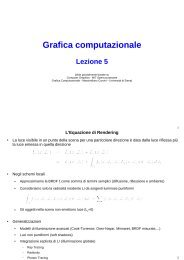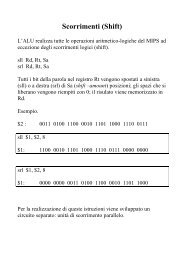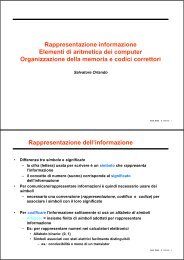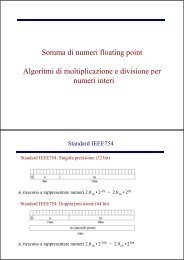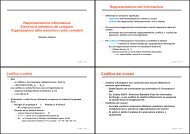Foscari - Dipartimento di Scienze Ambientali, Informatica e Statistica
Foscari - Dipartimento di Scienze Ambientali, Informatica e Statistica
Foscari - Dipartimento di Scienze Ambientali, Informatica e Statistica
Create successful ePaper yourself
Turn your PDF publications into a flip-book with our unique Google optimized e-Paper software.
Read the following article and decide if the following 8 statements are true or false( rispetto a cio<br />
<strong>di</strong>ce il brano). Mark an X in the relevant box.<br />
More than one million computers on the net have been hijacked to attack websites and pump out spam and<br />
viruses. The huge number was revealed by security researchers who have spent months tracking more than 100<br />
networks of remotely-controlled machines. The largest network of so-called zombie networks spied on by the<br />
team was made up of 50,000 hijacked home computers. Data was gathered using machines that looked innocent<br />
but which logged everything hackers <strong>di</strong>d to them.<br />
The detailed look at zombie or 'bot nets of hijacked computers was done by the Honeynet Project - a group of<br />
security researchers that gather information using networks of computers that act as "honey pots" to attract<br />
hackers and gather information about how they work. While 'bot nets have been known about for some time,<br />
estimates of how widespread they are from security firms have varied widely. Even in unskilled hands, it should<br />
be obvious that 'bot nets are a loaded and powerful weapon<br />
To gather its information the German arm of the Honeynet Project created software tools to log what happened<br />
to the machines they put on the web. Getting the machines hijacked was worryingly easy. The longest time a<br />
Honeynet machine survived without being found by an automatic attack tool was only a few minutes. The<br />
shortest compromise time was only a few seconds.<br />
The research found that, once compromised machines tend to report in to chat channels on IRC servers and wait<br />
instructions from the malicious hacker behind the tools used to recruit the machine. Many well-known<br />
vulnerabilities in the Windows operating system were exploited by 'bot net controllers to find and take over<br />
target machines. Especially coveted were home PCs sitting on broadband connections that are never turned off.<br />
The months of surveillance revealed that the <strong>di</strong>fferent 'bot nets - which involve a few hundred to tens of<br />
thousands of machines - are used for a variety of purposes. Many are used as relays for spam, to route unwanted<br />
adverts to PC users or as launch platforms for viruses. But the research team found that many are put to very<br />
<strong>di</strong>fferent uses. During the monitoring period, the team saw 'bot nets used to launch 226 <strong>di</strong>stributed denial-ofservice<br />
attacks on 99 separate targets. These attacks bombard websites with data in an attempt to overwhelm the<br />
target. Using a 'bot net of machines spread around <strong>di</strong>fferent networks and nations makes such attacks hard to<br />
defend against.<br />
One DDoS attack was used by one firm to knock its competitors offline. Other 'bot nets were used to abuse the<br />
Google Adsense program that rewards websites for <strong>di</strong>splaying adverts from the search engine. Some networks<br />
were used to abuse or manipulate online polls and games.<br />
Criminals also seem to be starting to use 'bot nets for mass identity theft, to host websites that look like those of<br />
banks so confidential information can be gathered and to peep into online traffic to steal sensitive data.<br />
"Leveraging the power of several thousand bots, it is viable to take down almost any website or network<br />
instantly," said the researchers. "Even in unskilled hands, it should be obvious that 'bot nets are a loaded and<br />
powerful weapon."<br />
Mark the following statements as True or False:<br />
True False<br />
1) The smallest network of computers found consisted of □ □<br />
100 machines.<br />
76



